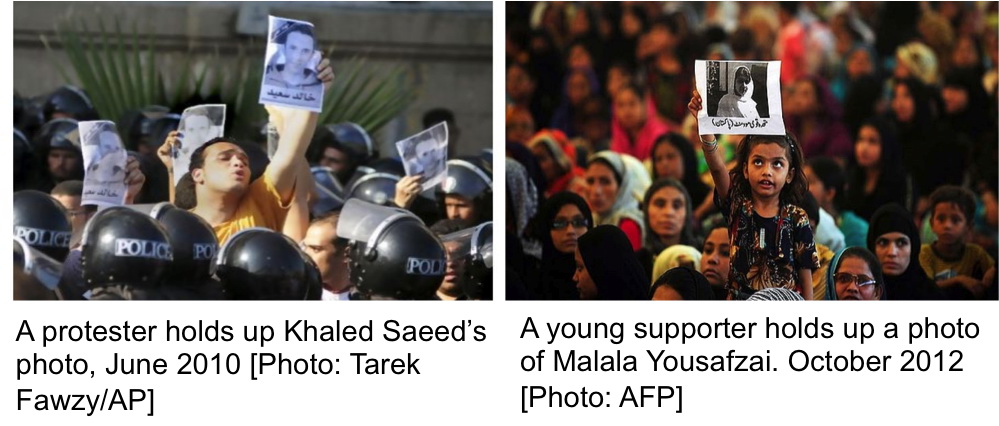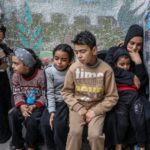Article published in openDemocracy, Egypt Monocle and Saudi Gazette
While reading the horrific case of Malala Yousafzai, the 14 year-old Pakistani girl who was shot in the face by the Talban for championing girls’ education, I came across a photo of a young supporter of Malala that triggered memories back to June 2010 of a similar image that has forever been engraved in my mind – an Egyptian youth protesting the tragic death of Khaled Saeed, the 28-year old Alexandrian who was beaten to death by policemen and would trigger the rapid countdown to the 2011 Egyptian revolution (See my detailed June piece Saeeds of Revolution: De-mythologizing Khaled Saeed).
The images provide a poignant and surreal expression of a protestor, in a repressive atmosphere, raising their hand held up high clenching a simple black and white A4 printout of their respective poster-child. It strikes deep at the heart of Arab regimes or fanatical organisations that have little appetite for dissent or any mere standing out from the crowd.
The differences between the cases of Khaled and Malala could not be more distinct: one lived in fear of a police state, the other in fear of an extreme misogynistic organisation; one going about his business, the other actively pushing for a cause; one died, the other survived. Yet it is the potent symbol they have become to their respective audiences that is revealing.
An icon becomes so when certain conditions, context, actors, and a clear oppressor-oppressed dichotomy are in place. Coupled with the dramatic demise or harm to the icon rendering them martyrs, living or dead. Moreover, what such figures do for the public is to humanise and personalise complex issues that in any other instance would have drifted into murky abstracts.
When opposition movements or simmering public grievances acquisition the martyr as their silent commander-in-chief, it can aid towards various outcomes: the most extreme being the overthrow of a regime – such as Tunisia’s Mohamed Bouazizi. Here there was a clear link between the fruit vendor’s self-immolation and the overthrow of the Zine El Abidine Ben Ali regime. This was not so immediate for Khaled, his death added to a long list of grievances but it certainly sped up a crumbling process.
There is, what may be called, a “post-event” martyr (I use such terms very loosely here), that hardens and swells the ranks of the opposition after the actual uprising or civil disobedience has started. We saw this with 12-year old Syrian, Hamza Ali Al-Khateeb – his horrific mutilation in May 2011 made him an icon. Egyptian activist Mina Daniel’s death, followed by Sheikh Emad Effat, nine months after the toppling of the Mubarak regime solidified the growing anti-military council’s public discourse and posthumously transformed them into powerful faces of the extended Egyptian Revolution.
Then there is the “dormant” martyr. Iran witnessed the death of Neda Agha-Soltan in 2009 at the height of opposition protests making her the poster-child of the disparate opposition groups, yet the Iranian regime and Mahmoud Ahmadinejad are very well still intact. It is not a case that Neda has simply fizzled out, the future has an uncanny way of resurrecting symbols following a successful opposition-backed uprising, revolution, coup, or democratic transition; the martyr is awaken from their slumber and reanimated with a vengeance – a new order, theoretically, will mythologise the role of Neda that will elevate her standing more than what she is seen as today.
Yet where does Malala fit in all of this? She miraculously survived, but not so the remaining ounces of the Taliban’s credibility. Even the most conservative Islamist groups were taken aback. It has also revealed one of the militant group’s biggest fears, as Mohammed Khalid Alyahya noted, “Malala Yousufzai took a bullet to teach us an invaluable lesson. The biggest threat to…Al Qaeda and the Taliban is not drone warfare or military crackdowns…it is the democratic empowerment of young people… Malala Yousufzai’s pen is mightier than the drone.”
A key Achilles Heel of the Taliban has been exposed.
While Malala, from her London hospital bed, uttered “What country am I in?” In the terrain of the Swat Valley, segments of the Taliban would have been uttering “What state of mind are we in?” Tragedies fragment perpetrators as much as they unite the victim’s sympathisers.
But there is no turning back now. Just as many, two years ago, were chanting “We are all Khaled Saeed”, now the world is more or less chanting “We are all Malala Yousafzai.”







